by tmoffett | Jun 14, 2012 | Color, Composition, Landscape
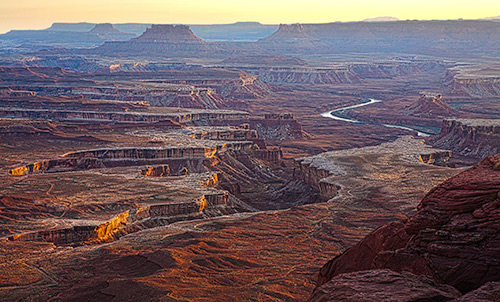
Canyonlands, Green River Overlook
I have been revisiting some images from past photo safari’s that I have taken and found this image from Canyonlands in Southern Utah. This is an area that I would very much like to visit again. The red rock canyons are very unique, and under good lighting conditions seem to glow. It is something that I don’t have here in Idaho (although we do have other features unique to us). I love, in this image, how the setting sun reflects off of the canyon walls, creating a warm glow that opens up the deep shadows deeper in the canyon. It also is full of dynamic lines zigzagging throughout with a dominant S-shaped curve in the river and the extreme depth created by the atmospheric haze. I vividly remember standing on the ledge overlooking the view, wind howling up the side of the cliff, totally in awe of the scene in front of me, wondering how I could do it any justice. I hope in some small way, I have. For me, at least, it reminds me of a very impressive time of my life. I live for these moments.
Next week I will be venturing out again on a much needed photo safari, this time to the Northern California coast. I have fallen in love with the ocean. It is almost therapeutic for me to sit and watch the waves pound the shoreline or gently lap up on a sandy beach. I could sit and watch for hours on end. Trying to create photographs that illuminate my feelings as I watch the waves in action is a challenge that, when successful, I find very rewarding.
by tmoffett | Jun 5, 2012 | Color, Landscape
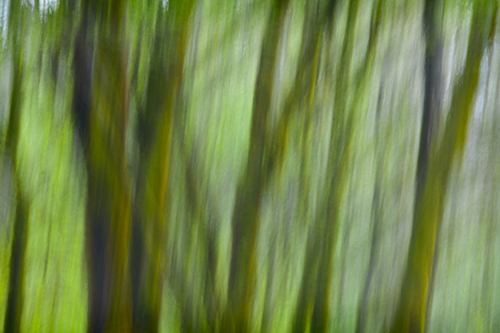
Trees at Dusk, Columbia River Gorge
After photographing waves on the ocean for four days and then waterfalls all afternoon, my whole mindset was motion. When looking at the trees, in my minds eye I could see their branches and leaves blowing in the breeze. The trouble was that there was no breeze! To get the look that I visualized, I moved the camera, creating the appearance of motion. I teach a unit at school in my advanced class on implied motion. I do not use the technique very often, but in this situation it worked perfectly.
My photography is not so much exploratory anymore, it is about creating images of my vision. I will explore whatever technique is needed for that purpose. I prefer to find my vision and then photograph rather than photograph to find my vision. For me, it is much powerful and rewarding that way.
by tmoffett | Jun 1, 2012 | Color, Ramblings
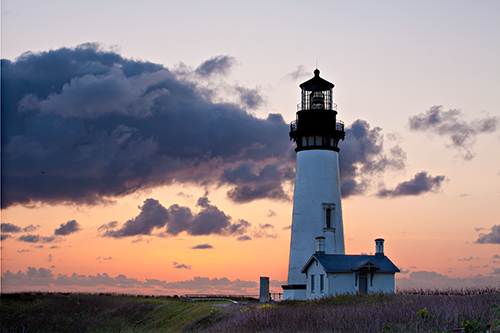
Sunset at Yaquina Head
Another school year is coming to a close. Today I have the last 2 classes final project presentations and critiques. It has been a year with many bumps along the way, but also a very good year. I have had some of the best students that I have ever had the privilege of working with in my advanced classes this year. Many very self motivated learners that have really made the year enjoyable. It is a joy to be in the classroom sharing my love of photography with young students who are just beginning to develop a passion for the arts. To my seniors, I wish you well as you move on to bigger and hopefully better things in life, and to the others, I hope to see you in the fall, ready to continue our journey.
Summer brings a whirlwind of activity in my life. My personal photographic projects take center stage. There will be photographic trips to the coast as well as family trips. Workshops to attend as well as teach. Plenty of work to do around the house as well as a full list of “honey-do” projects. Living a balanced life has always been difficult for me, but is a necessity. As an artist, my emotional status affects my work. When things are running smoothly and relationships are in good standing, then my mind is open to creative thinking. My vision is clear. When life gets out of balance, I feel burdened and am unable to work as freely. My mind kind of shuts down and I am unable to be as creative. My vision becomes clouded and it becomes difficult to work. Hopefully I can maintain balance in my life this summer!
by tmoffett | May 29, 2012 | Color, Landscape, Photographic Technique
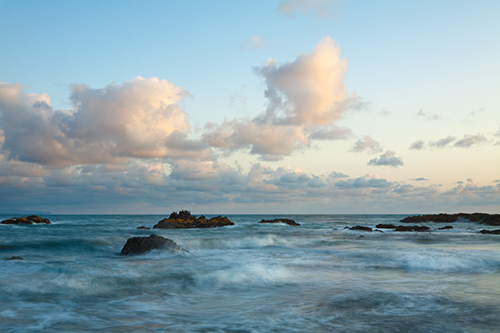
View from Cobble Beach, Newport, Oregon
I don’t know why, but I am really drawn to the water. Any water. Rivers. Streams. Lakes. But mostly the ocean. I am in the middle of giving final exams in my classes and I am really wishing I was at the beach with my camera instead. It doesn’t help matters that everywhere I turn I have photographs reminding me of how much I enjoy the coast.
One reason, I think, that I enjoy photographing moving water so much is the variety that it offers. You can stop the waves and capture every droplet of water as it sprays toward the shore, you can slow things down and capture the flow of the water over the rocks, or you can go anywhere in between. What I am feeling at the time usually dictates how I see the water and how I will photograph it. I often teach, especially in my beginner courses, to experiment with different exposure settings to see what happens to the image. I rarely do much experimenting when out photographing. I see what I see, my vision, and that is what I photograph. In earlier days I did the experimenting. I learned what happens when I use a long shutter speed. I learned how fast I needed to shoot to stop the water in a fast-flowing river. Now I spend more time experiencing the scene and then photographing it the way I feel it to be. The techniques have become my tools. I use these tools to create images resembling my vision. The tools enhance my creativity.
This particular evening at Cobble Beach, I met the Park Ranger as I was descending the steps to the beach. I was informed that I must be off the beach 10 minutes before sunset and out of the park 10 minutes after sunset. This threw a damper in my plans, as I love photographing long after the sun goes down. I felt rushed to get what I wanted, and upon reviewing my photographs from that evening, I think it affected me. Instead of creating soft, flowing images of a relatively smooth sea, I found myself using an “in between” shutter speed that would enhance the waves and make the scene appear more turbulent than maybe it really was. All of my exposures showed that look and feel. It was definitely different than what I shot the rest of that trip. It was proof to me that my emotions do affect the way I see, and therefore the way I photograph. I like it that way!
by tmoffett | May 24, 2012 | Color, Composition, Ramblings

Sunflowers, Lake Lowell
I like a simple life. A walk on the beach. An afternoon nap. Daydreaming. A bike ride. A good book and an hour to kill. When I can slow down and enjoy life, my vision becomes clearer. I see things that otherwise I may pass by.
It is too easy to let life get complicated, and then we miss so much. When rushing from point A to point B it is difficult to focus on the journey, yet the journey is what should be important. I have to remind myself often of that fact. This simple image of a couple of sunflowers is a reminder to me to simplify. As I was on a walk out at the lake one evening, I passed by a patch of sunflowers, and these two blossoms caught my attention. I had to work to find an angle that would isolate them and simplify the composition while maintaining the feeling that they instilled in me. Much like in life, simplifying takes effort. We must work at it and strive for it. When we succeed, it is a beautiful thing.
by tmoffett | May 22, 2012 | Color, Landscape, Photographic Philosophy, Photographic Technique
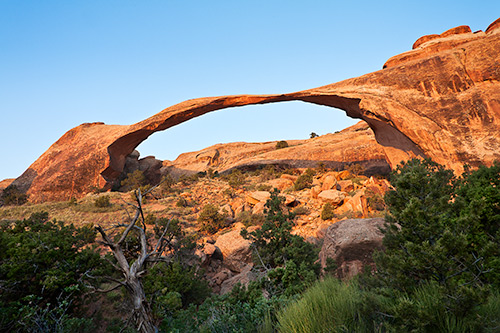
Landscape Arch, Arches National Park
My life can get quite crazy when on a photography trip. I arise early, oftentimes 4:00 A.M. or earlier and head out to a predetermined location. Frequently a pre-dawn hike is required and I arrive in plenty of time to prepare for sunrise. I never like to be rushed. Photography for me is not a job, it is an experience, and one to be enjoyed! Once I arrive at a location, I try never to hurry, I observe, I meditate, I let all of my senses go to work so that I can fully experience where I am. Only after I find myself can I really create an image that will have any impact at all. Once I have determined what it is that I will photograph and how I will photograph it, I set up and wait. As the sun nears the horizon, the light quality gets better and better, then all at once it becomes great! I shoot away, making subtle adjustments between exposures until everything is just right, then nearly as quickly as it came, the light is gone. Sometimes in the morning, the real good light only lasts a few short minutes, then it becomes harsh and uncontrollable. All of this effort for sometimes a mere five minutes of great light. Worth it? Absolutely! So much so that I turn around and do the same thing in the evening.
Evening photography is a little different than sunrise photography. The light quality stays good for me longer in the evening than in the morning, mostly because I love the light after the sun sets. I often, during the summer months, will shoot until after 10:00. This makes for some really short nights, but very much worth it in my opinion. I do need a few days to recover after returning home from a photography “vacation.” Why do I do it? It is who I am. I love photography, and great photographs are made at the ends of the day. I once heard a friend respond to someone questioning why it was necessary to get up so early. His response was that “At five o’clock you’re a photographer but at 11:00 you’re just another tourist.” How true that is. Avoiding tourists and enjoying the sights in a kind of light that you will never find at mid-day is part of what drives this passion of mine.








Recent Comments